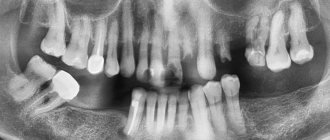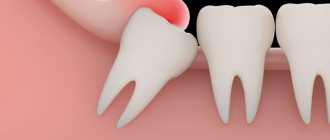Content:
- Why does it occur
- Signs
- How it proceeds
- Features of the development of periostitis in children and adults
- What happens if you don't undergo therapy?
- How to remove flux
- How to speed up recovery
- Preventive actions
An inflammatory dental disease that affects the periosteum tissue is called periostitis by dentists.
It is popularly known as flux. It is easy to recognize on your own - a painful abscess forms on the gum, which does not go away for a long time. It is unwise to fight this disease without medical help. When it appears, you should definitely make an appointment at a dental clinic and, during an in-person examination, find out from the doctor how to remove the flux without negative consequences for health.
It is simply impossible to ignore periostitis. It is usually accompanied by acute throbbing pain. Sometimes it can even lead to fever and a sharp decrease in performance. When there is a lot of pus in the “bag”, it bursts. Then the purulent masses flow out, and the symptoms cease to be so bright.
Home treatment is only a temporary measure
Many admit that they have tried treatment at home for gumboil. For example, they rinsed their mouth with tincture of calendula and propolis, “Rokotan” or “Stomatofit”, and applied a cotton wool with the same products to the inflamed gum. The listed remedies are relatively safe; they also help relieve pain and reduce the intensity of the inflammatory process. However, the effect of the application is temporary, and then you still have to go to the dentist, where specialists explain in detail how the gumboil is actually treated.
Gargling with medicinal herbs will only temporarily relieve symptoms.
Patients also note that when trying to quickly cure gumboil at home, they subsequently had no choice but to remove the tooth. After all, during the period of delay, the infection undermined the tissue even more.
“I will answer your question about how to treat flux at home quickly! No way at all!!!!! For me it flared up four times over the course of six months, and I rinsed it with all sorts of herbs and ants, applied aloe, and chewed propolis. All the time I found reasons not to go to the clinic: first I was in the garden, then I don’t have time, then I feel sorry for the money... I completed my treatment with such methods that half my face was bombed, and the doctors unanimously said that I needed to remove the tooth..."
Lioneva_Ste, review from 32top.ru
Why does it occur
In order to understand how to remove flux, it is necessary to establish what led to its appearance. If the provoking factor is not eliminated, the disease may return. Among the main reasons for the violation:
- untreated deep caries;
- a large amount of hard plaque extending far under the gum;
- dental root cyst;
- inflammatory lesion of the gingival pocket;
- receiving mechanical injuries;
- general hypothermia of the body (especially against the background of reduced immunity);
- poor oral hygiene.
According to statistics, most often the disease occurs precisely because of advanced caries and pulpitis. If there is a large “hole,” the infection easily penetrates deep into the dental tissues, affects the surrounding structures and causes nerve destruction. Then pulpitis develops.
If left untreated, it will become chronic. The pain will become mild, but this does not mean that the disease has gone away. It’s just that now it’s happening secretly. The infection will continue to destroy the internal structures of the diseased unit. As they die, narcotic masses will begin to be released. To remove them, an abscess forms on the gum. This is flux.
If it is localized on the periosteum of the upper jaw, then the upper lip and the area under the eye swell. If inflammation progresses in the lower jaw, the chin and cheek swell, and the lymph nodes become painful.
What to use first
Many folk remedies for gumboil have existed for tens and even hundreds of years, which indicates their effectiveness. They are justified from a medical point of view and are acceptable for use in everyday life:
- You need to start with a cool compress , which must be applied to the cheek where the swelling has appeared. It reduces the pain somewhat.
- A mixture of salt and soda will help you quickly get rid of gumboil . This is the easiest method of fighting. Baking soda softens inflamed gums, and salt relieves swelling and relieves pain. Dilute 1 teaspoon of salt and soda in 1 glass of lukewarm water. Add 5 drops of iodine and mix everything well. Every hour, thoroughly rinse your mouth with a warm solution, trying to keep it on the affected area for as long as possible.
- Lotions made from salt and soda also have an anti-inflammatory effect . Apply a small amount to cotton wool, soak in warm water and apply to the inflamed area.
- First aid during treatment is provided by soda compresses . Shape the cotton wool into a circle and add 1 teaspoon of baking soda. Roll the cotton wool so that the soda is inside. Dip it in warm water and place it behind the cheek, at the site of periostitis. If you keep the cotton wool for at least three hours, the flux will go away the next day.
Signs
You can understand that periostitis has developed by the following symptoms:
- tooth pain;
- swelling of the gums;
- an abscess at the base of the diseased unit;
- increased pain when pressing on the affected area;
- swelling of the cheek;
- increased body temperature;
- swelling of the lymph nodes.
If these symptoms occur, you should make an appointment with the dentist as soon as possible. In the early stages, the problem can be eliminated quite easily and quickly. Delay is fraught with health-threatening complications.
Diagnosis of tooth flux
At the dentist's appointment, a thorough examination of the oral cavity and an X-ray examination - a targeted or panoramic image - is carried out. In some cases, two studies will be required to make an objective diagnosis.
As soon as the diagnosis is made - exacerbation of chronic periodontitis and the diseased tooth is identified, the doctor begins treatment.
How it proceeds
The disease progresses through several successive stages:
- Acute serous. Spreads quickly. In just two or three days, a large, painful “bump” forms, with pus inside. The cheek tissues swell.
- Acute purulent. The pain becomes more pronounced, the person feels an unpleasant pulsation. The mucous membrane in the area of the affected unit turns red and swells. Body temperature rises.
- Acute diffuse. The swelling becomes voluminous. It can go under the eye or onto the nose. The patient's appearance changes significantly for the worse.
- Chronic. The painful process fades away and is replaced by a chronic one. The patient may mistakenly think that the problem has disappeared without a trace. In fact, it only calmed down for a while. Periodically, the disease will recur.
The sooner a sick person consults a doctor, the higher his chances of a speedy recovery.
Tinctures and ointments for tumor relief
You can learn how to remove swelling from gumboil from many collections of folk recipes. Regular vodka works well if you add eryngium, sage and perennial to it. For 100 g of liquid, take 1 tbsp of each herb. l. Keep sealed dishes in a dark room. Every 2 hours - this is how often you need to rinse your mouth. If the tooth hurts badly, place a moistened swab directly on it.
A good effect is obtained from an infusion of oak bark. Green tea with sage relieves swelling. Use hot with salt. The problem is solved with the help of alcohol tinctures. They are easy to make yourself, but there is also a wide selection in pharmacies. For this purpose, about 100 g of propolis is crushed and filled with a bottle of vodka. The dishes should be in a dark place. A cotton ball is soaked in the resulting product and placed between the cheek and gum. It will moisten your mouth and relieve swelling. To prevent pain from bothering you too much, you can chew propolis.
Flux is treated with ointments. They are easy to prepare yourself. They help quite well and can affect not only the tooth, but also the body as a whole. Calendula is suitable for this purpose. Its flowers are dried and mixed with fresh cow butter.
Boil 50 g of sunflower, olive or ricin oil over low heat, adding propolis (20 g). Leave in a cool place. Apply to the inflamed area at least 2 times a day.
If a person was really bothered by flux, his ancestors knew how to remove the tumor. They used a popular ointment made from honey. A tablespoon of propolis was added to olive or flax oil, of which 50 g were taken. The composition was prepared in a water bath. A tampon soaked in ointment was placed where the abscess appeared.
A rather strange treatment recipe is also known, which consists in putting a pulp obtained from garlic to the pulse on the wrist on the opposite side of the one where the diseased tooth is located. After half an hour of the compress, the patient felt much better.
Traditional medicine can cope with pain and help if your cheek is swollen, but to avoid unforeseen consequences, it is better to go to the doctor. Only a dentist will tell you the cause of the pain, make the correct diagnosis and provide professional assistance.
zubi.pro
Features of the development of periostitis in children and adults
In adults, the disease usually has vivid symptoms. Most often it is caused by bad habits and ignoring the rules of oral hygiene. The tissues surrounding the root become inflamed. Persistent pain forces a person to seek dental care.
In children, flux usually progresses with mild symptoms. This is due to the fact that in children the immune system reacts less actively to abnormal processes in the oral cavity. Even if the purulent “bump” does not hurt the child, a consultation with a dentist is still required.
Causes of swelling
A common situation is when a tooth hurts or a swollen cheek. An inflammatory process begins to develop in the inner part of the tooth. Sometimes the reason lies in incorrect surgical intervention by a specialist.
In general, we can identify the following factors of unpleasant sensations that are localized in the oral cavity:
- changes in pathological illness in the mouth area;
- diseases associated with disruption of the functional functioning of neighboring organs (for example, the maxillary sinus or trigeminal nerve);
- factors of discomfort in the oral cavity include the wrong course of treatment.
Unpleasant sensations may appear temporarily or be permanent. External irritants, such as sweet, hot or cold drinks, also have a huge impact. With slight pressure, an aggravation of this situation is observed.
If you suffer from a swollen cheek, you need to understand the reasons for this process. First of all, this concerns the diagnosis of periodontal disease. As you grow older, your gums lose their former elasticity and bleed constantly. Tooth enamel loses its former resistance to external irritants. This means that teeth and gums are quite easily susceptible to infection.
Sometimes the cheek becomes swollen from this infection. Use medications prescribed by your doctor for the course of treatment. Experts recommend removing the tooth, after which a prosthetic procedure should be performed.
The next disease that provokes swelling is an inflammatory infiltrate. Patients often encounter a situation where their cheek is swollen after dental treatment. For example, after therapy aimed at getting rid of apical periodontitis or pulpitis. A symptom that appears before the onset of swelling is a fairly severe toothache.
The main manifestations of inflammation are characterized by softening of soft tissues, or the gradual accumulation of pus. Subsequently, it penetrates into neighboring areas, and cases of entry into the circulatory system are possible. This process negatively affects the patient’s health and general well-being. In severe cases, death is possible. To protect yourself, you should seek help promptly.
The next option is that the wisdom tooth is growing in the wrong way. Due to the development of the eighth teeth or if the normal process of teething is disrupted, swelling of the cheek is possible. A mucous sac often appears at the site of inflammation. Leftover food often gets into its interior.
It is quite difficult to remove food from this area, so irritation of the mucous membrane occurs. This condition causes discomfort and the patient suffers from severe pain. In some cases, body temperature rises.
If the wisdom tooth grows partially, then the patient may suffer from discomfort while eating. After all, food particles injure the soft tissues of the cheek, and the size of the tumor increases.
There are cases when the cheek becomes swollen after tooth extraction. This situation is explained by unprofessional treatment. For example, if a nerve remains during filling. Even in the absence of pain, this situation is dangerous. If the patient does not take appropriate measures, in most cases he will lose a tooth.
Sometimes swelling may occur as a result of an allergic reaction. If this situation arises, the doctor must promptly remove the filling and replace the material that provoked the allergy with another (more neutral) material.
When the gum is cut, swelling may occur. This surgical intervention is performed if pus is present. At first, the tumor may increase in size.
Separately, it is worth noting the situation when a tooth was removed and the cheek became swollen. To minimize negative manifestations, experts advise not to touch the affected area with your tongue or hands for at least 24 hours. Also at this time it is prohibited to consume alcoholic beverages and hot dishes.
It is important to contact a qualified specialist if you notice the presence of one or more symptomatic signs:
- after your tooth was pulled out, your cheek became swollen;
- excess of normal body temperature;
- after you have had a tooth removed, you observe a constant increase in pain;
- swelling gradually expands its boundaries. In the future, if the patient does nothing, this can lead to suppuration.
What happens if you don't undergo therapy?
It is unacceptable to treat purulent gum lesions as a minor dental disorder. It is very insidious and rarely disappears without a trace on its own. Often, if treatment is refused, the following occurs:
- Abscess. It is a consequence of a long-term presence of a pus-filled sac in the area of the tooth root. The abscess grows and then ruptures.
- Phlegmon. Represents an extended lesion. It usually occurs after a rupture of a purulent sac, if the patient does not comply with the dentist’s instructions, does not rinse the mouth with a special antiseptic solution, or apply anti-inflammatory gels.
- Osteomyelitis of the jaw. It occurs if the gums are not treated for a very long time. The pathological process spreads to the jaw bone, which is very dangerous.
- Inflammation of individual sinuses of the skull. It is also diagnosed with advanced periostitis. The maxillary, frontal and sphenoid sinuses are affected.
It is extremely rare that the disease affects brain tissue. Then the person may even die.
Tincture recipes
Various alcohol tinctures are also widely used in treatment. You can buy them not only in pharmacies, but also make them yourself.
Grind 90 g of propolis and pour in 1/2 liter of vodka. Keep the resulting mixture in a dark place for 2 weeks, shaking occasionally. Strain the tincture and store in a dark container in a cool place. Soak a cotton ball in the tincture and place it between the gum and cheek overnight.
This allows you to remove the swelling in the mouth caused by the flux in one day, the pain will gradually go away. The pain will also decrease if you simply chew propolis throughout the day.
How to remove flux
To avoid purulent damage to the pulp zone and periosteum, you need to receive qualified dental care in a timely manner. In the early stages of the disease, in order to prevent further progression of the inflammatory process, the patient is prescribed anti-inflammatory drugs and antibiotics. It is mandatory to open the abscess. The wound is then cleaned and washed with an antiseptic.
In some cases, to prevent re-accumulation of pus, drainage is installed for several days. All surgical procedures are always performed under general anesthesia so that the patient does not experience pain.
To support the patient’s body, he is additionally prescribed a vitamin and mineral complex. If necessary, physiotherapy is included in the treatment course. Good results can be obtained using UHF and electrophoresis.
It is important to strictly follow all medical recommendations and under no circumstances interrupt antibiotic therapy. Treatment is considered successfully completed if pus is no longer released, pain does not occur, and the entire wound has healed. In some cases, after healing, a small bluish scar remains on the gum. You shouldn't worry about it. This means that the defeat was very deep. Over time, the gums will return to their normal appearance.
How to rinse your mouth with flux
Rinse solutions in the initial stages of the disease can have an anti-inflammatory effect and prevent the development of an abscess. If, nevertheless, the dentist had to open the source of suppuration, he will definitely tell you how to rinse the flux in order to avoid further spread of inflammation and quickly eliminate the symptoms.
Soda
Regular baking soda is the simplest and most reliable remedy for periostitis. It will quickly eliminate swelling, relieve pain for a long time and stop the inflammatory process. To prepare a solution for rinsing from flux, you need to dissolve a full teaspoon of soda in 200 ml of cooled boiled water. Rinse your mouth every 2 hours until the acute manifestations of the disease subside. Then the procedure can be repeated 4-5 times a day until complete recovery.
Rotokan
The basis of the drug is an alcoholic infusion of medicinal herbs: calendula, chamomile and yarrow. Rinsing the mouth with flux with a rotokan solution has an antiseptic effect, reduces painful manifestations, and relieves inflammation. Dissolve 5 ml of the product (1 teaspoon) in a glass of warm water and rinse every 2-3 hours until the pain subsides. In the stage of subsidence of the inflammatory process, the procedure is carried out 3-4 times a day.
Malavit
The drug contains natural extracts of medicinal herbs, silver and copper ions, due to which Malavit has an antibacterial effect, relieves even severe tissue swelling, relieves pain and prevents the spread of infection. 5-10 drops of the medicine should be dissolved in warm, but not boiled water. Rinse your mouth 5-7 times a day until the condition improves. In order to consolidate the anti-inflammatory effect, repeat the procedure three times a day until complete recovery.
Chlorhexidine
The drug has a detrimental effect on almost all groups of pathogenic microorganisms. When applied topically, it has a pronounced anti-inflammatory and wound-healing effect. Mouth rinsing with flux is carried out with a 0.5% aqueous solution of chlorhexidine 4 times a day until the clinical manifestations subside.
Betadine
Thanks to the active iodine included in the drug, betadine perfectly fights pathogenic bacteria, eliminates inflammation, prevents the formation of a purulent focus and promotes the rapid healing of damaged tissues. To prepare a solution for rinsing the mouth, a teaspoon of 1% of the drug is dissolved in a quarter glass of warm water and rinsed 4 times a day until symptoms relieve.
Furacilin
Flux agent with a strong antibacterial effect. To rinse, dissolve 1 tablet of furatsilin in a glass of boiling water. After the solution has cooled, rinse your mouth every 2-3 hours until the pain subsides and the swelling on the cheek subsides.
How to speed up recovery
To make healing go faster, it is important not only to follow the dentist’s instructions, but also to remember the rules:
- do not heat the area where the pus was located;
- do not take antibiotics or any other medications unless prescribed by a doctor;
- do not use any folk recipes without consulting your doctor;
- Until the wound is completely healed, do not use aspirin or any medications that contain acetylsalicylic acid.
If the “bump” appears again, it is recommended to immediately contact a dental clinic.
Tooth gumboil: what medications to take?
This is the most common question in Internet search engines when people try to deal with the problem on their own. Our answer: “Do not take anything before consulting a doctor!” Only the attending physician, taking into account the stage of the disease and your individual characteristics, can prescribe an antibiotic for tooth flux, which stops the inflammation process. The dentist will also advise which drug is best to use as an anesthetic.
Preventive actions
To reduce the likelihood of periostitis, you need to take care of your teeth and visit the dentist at least once a year. You can't start caries. As soon as a dark spot appears on the surface of the dental crown, it needs to be treated.
After eating, it is advisable to rinse your mouth with warm water. To make hygiene as high as possible, it makes sense to use not only a brush and toothpaste, but also dental floss and irrigators. It is very important to remove tartar every year at the dentist's office.
An important place in the issue of prevention is given to diet. You should eat as much fresh fruits, vegetables, and plant foods as possible. They require more thorough chewing and thus have a positive effect on the ligamentous apparatus that holds the tooth. They also provide natural cleansing of crowns from soft plaque.
If you have any questions about how to remove flux, please contact the doctors at the Line of Smile dental clinic for help. We specialize in the treatment of this disease and know how to quickly rid our patients of it.
Interaction with a doctor will give quick and successful results
Almost all people sooner or later go to the doctor with gumboil. Some come in the early stages. And someone - because they tried home treatment, but could not cope or realized that the actions were inappropriate, and the infection began to seriously threaten their health.
The clinic carries out professional surgical and therapeutic measures to eliminate not only the purulent process, but also the causes of its appearance. Afterwards, the doctor usually gives recommendations and advises how and with what to treat gumboil at home in each specific case. A number of medications are prescribed: antibiotics, antiseptics, vitamins to boost immunity, ointments and applications.
If you have any symptoms, you should consult a specialist
Physiotherapy (electrophoresis, ultrasound and laser therapy) is also often added to the serious list of medications. At home, you need to carry out thorough but gentle oral hygiene and exclude irritating foods (hard, cold, spicy) from your diet.
It is very important for the patient to take all recommendations seriously. You need to visit a doctor to monitor the condition and until you are completely cured. After flux treatment, it is recommended to undergo medical examinations twice a year in order to promptly identify all dental diseases that can lead to the development of pathology.
Notice
: Undefined variable: post_id in
/home/c/ch75405/public_html/wp-content/themes/UltraSmile/single-item.php
on line
45 Notice
: Undefined variable: full in
/home/c/ch75405/public_html/wp-content /themes/UltraSmile/single-item.php
on line
46
Rate this article:
( 3 ratings, average: 5.00 out of 5)
flux
- Kabanova S.A. Antibiotic therapy of purulent-inflammatory processes in the maxillofacial area on an outpatient basis // Bulletin of Vitebsk State Medical University. – 2008.
Expert “Flux is a disease whose treatment should be entrusted exclusively to a doctor. The specialist will carefully make an incision into the inflamed tissue and release the serous or purulent fluid that has formed inside. In some cases, drainage is installed to ensure complete drainage of pus. All procedures are carried out under sterile conditions. After the operation, you will definitely be prescribed medications and antibiotics to avoid complications and ensure quick rehabilitation.” Dentist-therapist Elena Vladimirovna Orlova
Consulting specialist
Dzagurova Elina Ruslanovna
Doctor rating: 9.5 out of 10 (2) Specialization: Dentist-therapist Experience: 11 years









